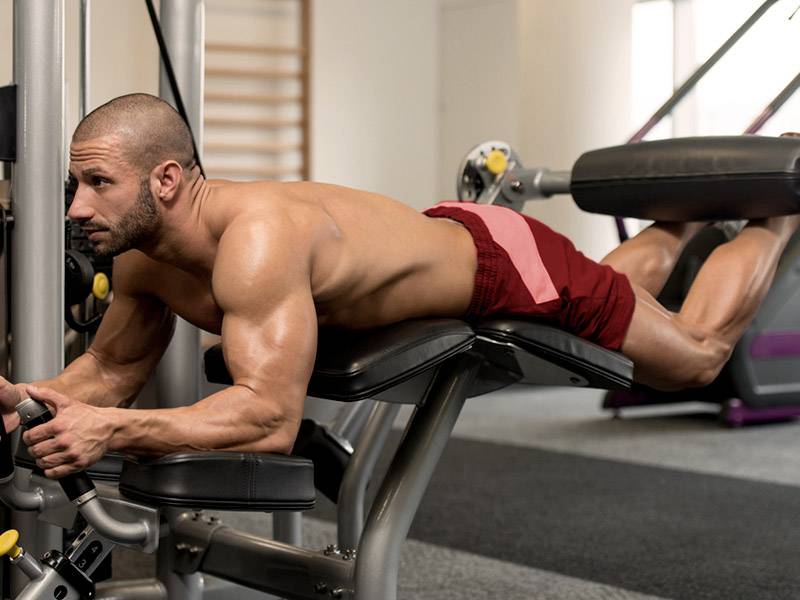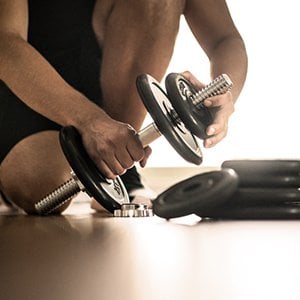
How To Do Leg Curls: Variations for Home & Gym
Key Takeaways
- Leg curls predominantly work the hamstring muscles, which tend to be underdeveloped if lifters don’t make them a priority. Other muscles worked include the calves, shins, glutes and quads.
- Leg curls can be done at the gym using weight machines or the cable machine. They can also be done at home using a dumbbell or kettlebell for weight.
- On top of variations, there are many alternatives to the leg curls that we compare for best hamstring and calf workout effectiveness.
Strong hamstrings make for stronger knees. If you feel like your knees could use a little more support, a hamstring-focused exercise like the leg curl can help.
There are different ways to do the leg curl and each way will work different muscle groups. Today you’ll learn how to do the standing leg curl, seated leg curl and lying leg curl, with and without a machine.
Before we get into instructions on the various leg curls, let’s talk about benefits and muscles worked.
Leg Curl Benefits
Some of you may wonder if there are any benefits to leg curls. We can argue that any exercise has its benefits and leg curls are no exception.
The hamstring muscles tend to be ignored in the gym, more so than other muscle groups. This is a shame, since there are more to strong hamstrings than aesthetics. These muscles contribute to a functional life by supporting both the posterior chain and knees.

If you suffer from sore knees, lower back pain or poor posture, strengthening your hamstrings can help. There are other benefits to doing leg curls and building the hamstrings:
- Prevents injuries
- Improves balance
- Improves muscle recovery
- May help release tension in peripheral nerves
- Improve athletic performance
- Encourages metabolic waste disposal
- Improves heart health
Take a look in the mirror, what do you see? A well-defined upper body with less low body definition? If so, you may want to focus more on strengthening your lower body muscles to balance out your upper body.
Leg Curls: Muscles Worked
The leg curl is an isolation exercise that focuses on two major muscle groups: the calf muscles and the hamstrings. Some positions include glute and quad activation, but the main focus is hamstring and calves.

Leg curls can be done in several positions and with different equipment. Today, we’ll discuss how to do the:
- Seated leg curl
- Lying leg curl (with machine)
- Lying leg curl (at home)
- Standing leg curl (no weights)
Leg curls are a versatile exercise and can be done with different equipment. If you don’t have a dumbbell for the at home lying leg curl, you can use a resistance band instead. Try each leg curl out to see which works best for you.
First, let’s go over the steps for the seated leg curl.
Seated Leg Curls
The seated leg curl is a machine-based exercise that targets the hamstrings more than the calves. If you’re looking for an isolation move to target the hamstrings, consider the seated leg curl.
The leg curl machine consists of a bench with a levered lifting bar at the base of the machine. Weights can be added to the bar or adjusted with a pin if this is a cable machine. There are two pads, one to support the ankles and the other to hold the legs down.

Before you begin, you need to adjust the seat so your body is in the right position:
- Your back should be flat against the back of the bench.
- The leg pad should rest on your thighs, closer to your knees than hips.
- The ankle pad should be behind your ankles, just above the ankle bones.
Once you’ve got the weight set up (enough for a challenge but not too heavy to strain your muscles), you’re ready to begin.
- Hold the handle bars in each hand and raise your legs until they are fully extended. They should be parallel to the ground.
- Bend your knees and lower your legs down until they are at a 90-degree angle. Exhale as you lower your legs.
- Pause before you lift your legs back up to the starting position, inhaling on the way up.
- Repeat for the desired reps to complete the set.
Lying Machine Leg Curl
An alternative to the seated leg curl, the lying leg curl will work the hamstrings, glutes, shines, and calves.

This setup includes a flat bench to lie down on with a levered lifting bar at the end. Weights get added to the bar or, if this is a cable machine, the pin can be moved to change the resistance.
This machine doesn’t require as much setup as the seated leg curl. Once you’ve selected your weight, you’ll lie face down on the flat bench. The support pad should be above your heel but below your calf muscle.
- Set your weight and get into position on the lying bilateral leg curl machine.
- Stretch your legs out so they are straight.
- Grasp the handles on either side of the bench or machine. Inhale before you move on to the next step.
- Exhale as you lift your feet up towards your body in a smooth and steady motion. Make sure your hips stay flat on the bench as you lift.
- Inhale while flexing your knees to pull your calves up towards your glutes.
- Pause and exhale before you start the descent.
- Inhale again as you smoothly lower your legs back down, maintaining control along the way.
Lying Leg Curl without a Machine
The leg curl exercise can be done with a machine which is perfect for someone working out at home. You will need a dumbbell and a place to lay comfortably face down on the floor.
This exercise is similar to the lying machine leg curl, with a dumbbell in place of the weighted bar. Start out with a light weight dumbbell first to get the form down, then increase the weight as needed.
- Grasp the dumbbell between your foot arches, holding it by the handle. This placement will help center the weight so it doesn’t shift while performing the curls.
- Lie down in the prone position on the floor or a mat. Bend your arms at the elbows and use them to prop your torso up.
- Engage your core and lift the dumbbell up slowly until your knees are at a 90-degree angle.
- Pause for a second before you begin to slowly lower the dumbbell back down to the ground.
Inhale as you move the dumbbell up and exhale on the way down.
Always start with a light weight to avoid injury. The lying position puts the lower back in a more vulnerable position. If the weight is too heavy and you’re straining to lift it, this could put unnecessary stress on your back.
Standing Leg Curl
The standing leg curl is the lowest impact as it does not require any weights. This is great for someone who cannot do the other weighted leg curls because of injury.
This leg curl can be done at home or at the gym. It can also be used as a warm up for other leg curls or hamstring exercises.
- Stand with your hands at your waist or holding onto a chair for balance. Your feet should be hip-width apart.
- Engage your core for balance and shift your weight onto one leg. Bend your other leg at the knee, bringing your heel towards your glutes.
- Pause at the top for a second before slowly lowering your foot back down to the ground.
- Continue by lifting the same leg for the remaining reps or alternate legs.
In the end, you should have the same number of reps for each leg.
Reps and Sets
The amount of reps and sets to do for each exercise depends on your goal.
If you’re looking to build strength, then stick with reps in the 8 to 10 range for three sets. Work your legs once or twice a week. Advanced lifters may do three or four days a week, depending on your workout schedule.
If you’re more focused on building endurance and stamina, lower the weight and increase the reps. Shoot for 12 to 15 reps and three or four sets once or twice a week.
When to Avoid Leg Curls
Leg curls are not for everyone. Overtraining the hamstrings can cause painful tightening, forcing more rest days and delaying your gym sessions.

Be sure to stretch before you train to get your hamstrings ready for the workout. Include other exercises, like the hamstring extension or squats, to work the rest of the leg muscles.
If you have any of these issues, you may want to avoid leg curls:
- Instability or injuries to the knee
- Recent hip or knee surgery
- Current injury to the knee or hip (torn or ruptured tendons or ligaments)
- Still recovering from a leg or posterior chain surgery
When in doubt, speak with your doctor if you’ve had any prior issues with your hips, knees, or hamstrings. If leg curls aren’t right for you, there are alternatives you can try.
Leg Curl Alternatives
If you can’t do leg curls or just want some other lower leg exercises to add to your routine, consider:
- Glute ham raise
- Kettlebell swings
- Stiff-legged deadlift (with barbell or dumbbells)
- Deadlift
- Hip extensions
- Good mornings
- Glute bridges
- Hamstring curls
- Romanian deadlift
- Back extensions
- Squats
- Calf raises
These alternatives can be included in your leg day to work the hamstrings, glutes, quads, and calves.
Tip From The Coach

“In order to keep the hamstring development in proportion to the powerful quadriceps, it is a good idea to do the hamstrings first in your leg workout followed by quads. Another alternative is to train hamstrings on different days than the quadriceps. For example, you could train abdominals and quadriceps one workout followed by hamstrings and calves the following day.”
— John Hansen, 3-time Natural Olympia winner and OSL ambassador
Final Thoughts
Leg curls can be an underutilized leg exercise that focuses primarily on the hamstrings. The hamstring muscle tends to be the least worked leg muscle, which can cause weak knees.
Leg curls can be done at home or at the gym using a cable machine or weighted machine. You can do leg curls in the prone position or seated. These different options make leg curls a versatile hamstring exercise to balance out the lower body definition.
If you’re able to do leg curls as part of your routine, you’ll soon notice stronger legs and glutes. Vintage Build™ can provide the energy and muscle building ingredients needed to power through your workout. Amino acids and BCAAs will aid in faster recovery to get you back to your workouts quicker.
Are leg curls a part of your lower leg workout? If not, is there another hamstring workout you prefer? Let us know what works for you in the comments below.









